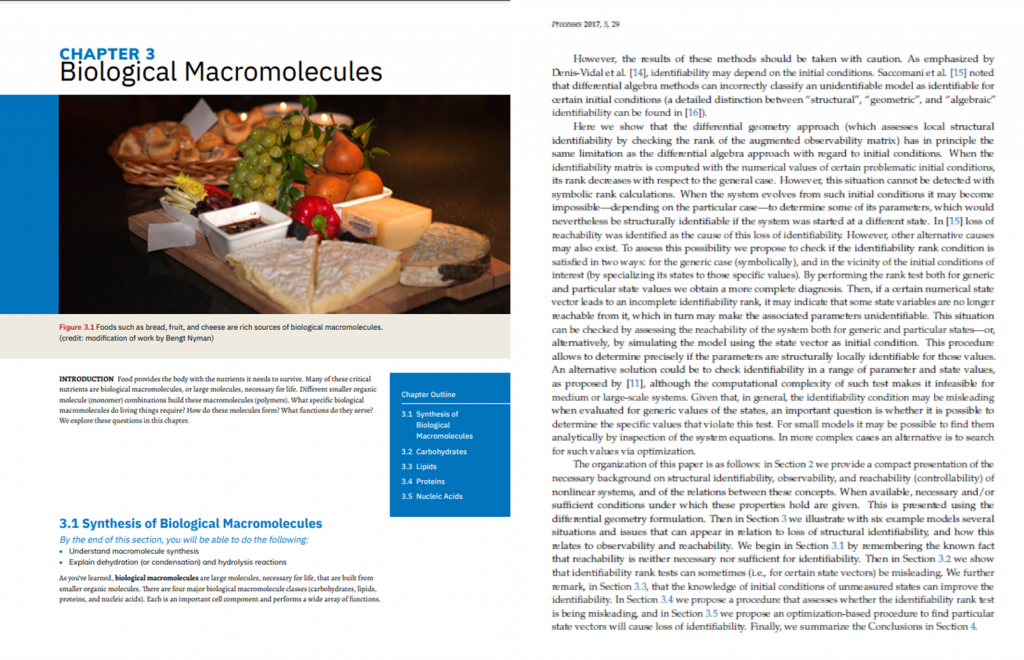What is a textbook?
Writing a textbook is not the same as writing a monograph, although a monograph can and often is used as a textbook. A textbook generally has a particular structure and specific components that make it a useful learning tool. Textbooks offer structure and scaffolding. Many include learning activities or other assessments. The language of a textbook is carefully crafted to match the educational level of the course. Textbooks are much more complex than most other publications. Not only do they need to cover a body of knowledge in a structured and logical way, but they also utilize design elements to help the learner better understand the subject.
Please note that a textbook is not a brain dump of everything you know about a subject. It is carefully scoped to suit your course’s and your students’ needs. Generally, a textbook is about 150,000 words in length. Individual chapters should average 3,000-4,000 words and never exceed 10,000 words.
Introduction
Read the section below on creating a textbook or watch the video: Textbook Development Techniques and Elements by Open Education Network on YouTube (CC BY 3.0 )
For a very helpful introduction to textbooks, watch
Characteristics of a textbook , a seven-minute video by Oxford University Press Southern Africa.
In this section, we will highlight some basic textbook design concepts. So, what makes a textbook a textbook?

Textbook structure
The tree structure
Textbooks can be thought of as having content divided into a tree structure. The terms used to name these structures could differ from book to book, but you will need to determine the terms used and the number of sub-levels in the tree. Think of it as the highest-level outline for the book’s structure. For instance, a textbook could have the following tree structure:
The “Book” is always the trunk of the tree, with the next level usually being “Chapter” or “Unit.” Determining this structure will eventually lead to the full book structure. For example, if the author decides to structure the book with
the completed book structure could look like this (showing chapter one sections only):
Structural elements
Each element in the tree consists of structural elements designed to aid learning. Some of these elements are what set textbooks apart from other books. They provide structure, context, overview, motivation, review, and other functions that are useful for learning. Dividing these elements into categories can be helpful when helping authors think about the elements they might want to use. Three element types help structure the textbook’s content: Openers, Closers, and Integrated Pedagogical Devices (Schneider, 2008).
Openers
Openers are structural elements that come before the main content of a tree level. Openers help lead the learner into the content. They could provide motivation and understanding of the structure of the content or a summary of what is to come. For example, chapter openers could include:
-
- a banner image
- learning objectives
- introduction
- focus questions
- chapter summary
Closers
Closers are structural elements that typically help learners review or reinforce their learning. Closers are typically found after the main content of a tree level. Closers often help students summarize, review, or practice what they’ve learned. Some example chapter closers are:
- review problems
- chapter summary
- links to external resources
For example, each chapter in a textbook could have the following standard structure that utilizes opener and closer elements:
Note that openers and closers can happen at each level of the tree, including the book, chapter, section, etc.
Integrated pedagogical devices
Integrated pedagogical devices1 are strategies and elements used in the main content of a tree element to assist in learning. Often, these devices use design to differentiate each element, which separates them from the rest of the content and makes the element recognizable through consistent use in each chapter, section, etc.
For example, each chapter in a mathematics textbook might have:
- a “Biography” element that highlights the biography and accomplishments of a famous mathematician
- a “Case Study” element that illustrates the concepts by describing a real-world application
- vocabulary words in bold
- illustration of geometric figures
- graphs
See a list of common Integrated Pedagogical Devices.
In summary, structural elements aid in learning. They provide context and structure and can play a role in motivating learners, helping them reflect, and extending their understanding. Structural elements should be used consistently throughout the text so that all instances of a tree element are structured the same. This lessens the cognitive load on students by making the content more easily recognizable.
Sources
Schneider, D. K. (2008, September 3). Textbook writing tutorial. Retrieved March 04, 2018, from http://edutechwiki.unige.ch/en/Textbook_writing_tutorial
For simplicity, Integrated Pedagogical Devices and Interior Feature Strands – as defined by Schneider – have been combined into one broad category we’re calling Integrated Pedagogical Devices.
Attribution



